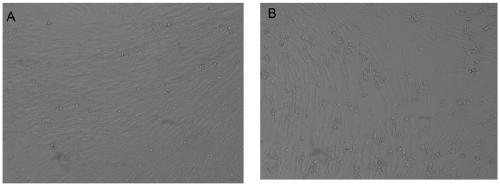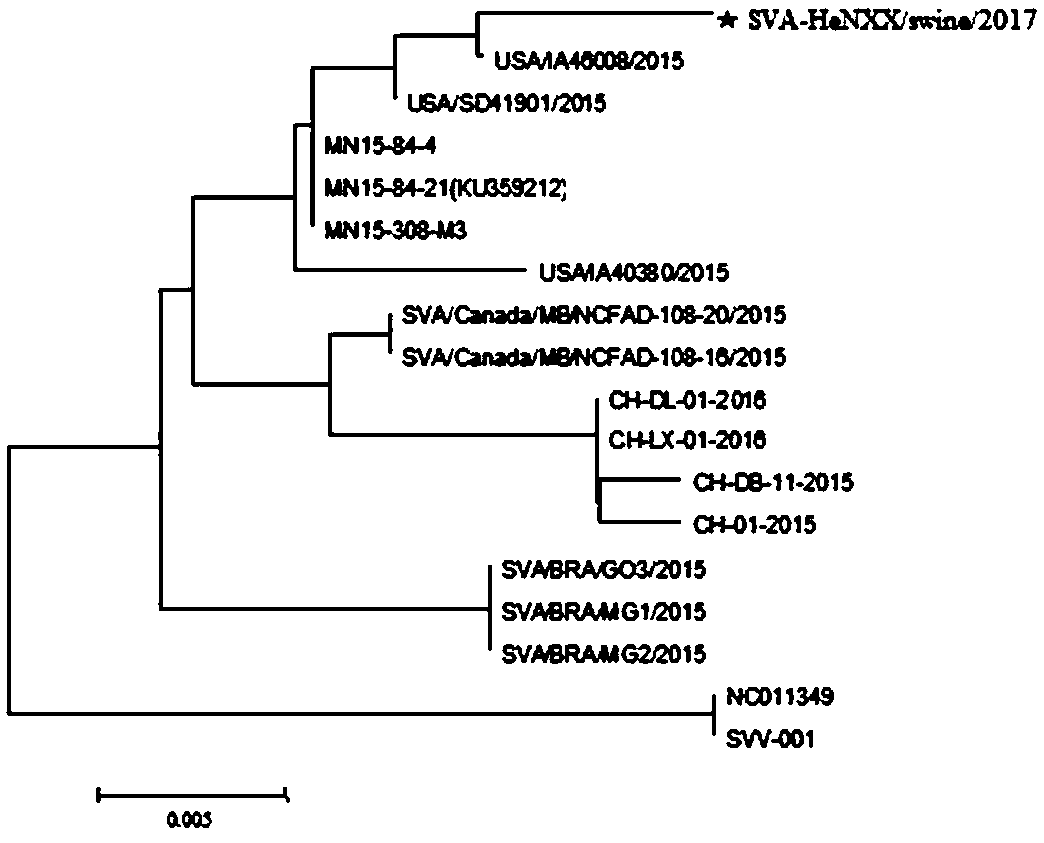Seneca valley virus strain and application thereof
A Seneca, virus technology, applied in the direction of viruses, viral peptides, antiviral agents, etc., to achieve the effect of good immunogenicity, immune protection, and good immunogenicity
- Summary
- Abstract
- Description
- Claims
- Application Information
AI Technical Summary
Problems solved by technology
Method used
Image
Examples
Embodiment 1
[0049] Example 1 Isolation and purification of SVV strains
[0050] 1. Sample processing
[0051] Collect the vesicle fluid or vesicle skin of diseased pigs whose SVV fluorescence quantitative PCR test is positive, prepare a 1:5 suspension with MEM, homogenize with a homogenizer for 5 minutes, centrifuge at 8000r / min for 10 minutes at 4°C, and take The supernatant was filtered with a 0.22 μm filter to obtain a sample treatment solution.
[0052] 2. Virus isolation
[0053]Take the BHK-21 cells that are covered with a single layer and in a good growth state to inoculate the sample treatment solution obtained in step 1. Wash BHK-21 cells twice with serum-free D-Hanks solution before inoculation, add 1 mL of the filtered SVV positive suspension to a T 25 cell culture flask, and store in 5% CO 2 , Cultivate in a cell incubator at 37°C for 1 hour, shake the cell culture bottle once every 20 minutes, so that the virus in the treatment solution can fully contact with the cells and...
Embodiment 2
[0077] The identification of embodiment 2 SVV
[0078] 1. RT-PCR detection method and gene sequencing analysis and identification
[0079] Referring to the RT-PCR identification method of SVV isolated strains in Example 1, the 3D gene of SVV was amplified, and the target fragment was purified and recovered and cloned into the pGEM-T vector for sequencing and sequence analysis. The results showed that the SVV gene could be amplified. 3D target gene.
[0080] According to gene sequencing analysis, the SVV-HeNXX / swine / 2017 strain has a homology of 97.4% with the CH-01-2015 strain that was first isolated in Guangdong, my country in 2015, and the SVV-HeNXX / swine / 2017 strain has 2 American strains In one branch, it has the closest homology with USA / IA46008 / 2015, with a nucleotide identity of 99.4% ( figure 2 ).
[0081] 2. Identification of SVV-HeNXX / swine / 2017 strain by fluorescence quantitative PCR (FQ-PCR)
[0082] On the basis of the RT-PCR detection method of SVV above, ref...
Embodiment 3
[0087] Example 3 Establishment of SVV-HeNXX / swine / 2017 strain to challenge mice
[0088] Six 8-week-old Balb / C female mice, 2 were intraperitoneally injected with SVV cell culture stock solution, 2 lived together, and 2 were reared alone as a negative control; the prepared SVV-HeNXX / swine / 2017 strain was injected intraperitoneally To challenge the virus, the dose of challenge was 200 μL per mouse (containing 10 10 TCID 50), and the other two were housed in the same cage. After the challenge, the mice showed symptoms such as curling up, rough coat, and listlessness, and suspected blister-like protrusions appeared on the nose of the challenged mice, and the cohabitation and negative control mice showed no abnormalities. The heart, liver, spleen, lung, kidney, intestine and nose of the challenged mice were all positive for SVV virus nucleic acid, and no SVV pathogen was detected in the tissues of the cohabitation and negative control mice.
PUM
| Property | Measurement | Unit |
|---|---|---|
| diameter | aaaaa | aaaaa |
Abstract
Description
Claims
Application Information
 Login to View More
Login to View More - R&D
- Intellectual Property
- Life Sciences
- Materials
- Tech Scout
- Unparalleled Data Quality
- Higher Quality Content
- 60% Fewer Hallucinations
Browse by: Latest US Patents, China's latest patents, Technical Efficacy Thesaurus, Application Domain, Technology Topic, Popular Technical Reports.
© 2025 PatSnap. All rights reserved.Legal|Privacy policy|Modern Slavery Act Transparency Statement|Sitemap|About US| Contact US: help@patsnap.com



